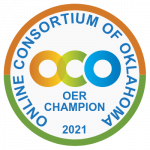11 Final Assessment
Congratulations!
Thank you for taking the time to complete this professional development! We understand learning about OER and applying open licensing concepts to adapt or create your own work is an incremental process! Please come back to these modules to review at any time. We will keep the links and Oklahoma-related information updated. To receive a certificate of completion via digital badge for these modules, please complete and submit the final assessment linked below.
Before moving on to the final assessment, consider the opportunity described below to start using your skills right away; then, review your Concept Review Answers here.
About the Final Assessment & How to Claim Your OER Champion Digital Badge
The Final Assessment will test your knowledge of the material presented in these modules. Complete the final assessment below; you may retake it as many times as you wish. When you achieve 80% or above, you will receive the Certificate of Completion. This certificate can be submitted to the appropriate department at your institution to potentially earn hours toward professional development or continuing education units (CEU). The recommended number of hours is three (or .3 CEUs).
Go to the Final Assessment for OER: A Deeper Dive in the OCO Learning Portal to Earn Your OER Champion digital credential!

Optional Concept Review Bonus – Take your Next Steps Plan to the Next Level & Apply Your Skills Right Away
Below is an additional bonus exercise for these modules where you can create your own OER at a later date. This supplementary exercise will provide you an additional opportunity to further apply all that you have learned in Chapters 1-9.
Choose one of the three prompts to create an open educational resource. This can be a blog, vlog, Libguide page, a slide deck, a short video, a handout, or other. For this exercise, be sure your resource is licensed CC BY. Here are some ideas, but feel free to create your OER based on your department culture or course needs. The goal is that you will use this OER!
- Create an OER which reflects something you need for your course – start small, such as one teaching unit
- Create an OER that informs faculty or students on the importance of active and engaged teaching
- Create an OER on five (or so) tips you deem important for faculty to ensure they are following best practices in regarding adopting, adapting, or creating OER
Be sure your resource is properly marked with an open license and publicly accessible (public link sharing in Google Docs is acceptable if you are not ready to make it broadly discoverable). If you would like to adapt a resource that already exists, make sure to provide a link to the original version so we can see the improvements you made. HINT: TASL!
Remember that a successful transition to opening of your resources demands a philosophical shift at the core of some of your educational practices, particularly those related to how you put together materials and prepare for class sessions.
Here is an example of an openly licensed handout on open education for faculty. It was created with a Google Docs template. The handout was adapted from an existing OER (see attribution statement) and modified to meet the needs of the creator for a faculty workshop.
Open Education (OE): A Fact Sheet for Faculty
Once you have created your OER, consider emailing the resource link to your colleagues or students for review.

